
If you're going gluten-free, chances are, you'll need to find swaps for some of the ingredients you use for both cooking and baking.
Following a gluten-free diet means you avoid the protein gluten, which is found in wheat, barley and rye. "When people with celiac disease [an autoimmune disease] eat gluten, their immune system attacks the lining of their small intestine," explains Sofia Norton, RD. That can cause damage to nutrient-absorbing tissue in the gut and lead to long-term health problems like low energy, weak bones and anemia.
But steering clear of gluten doesn't mean you have to avoid all your favorite foods — it just means you have to get creative in the kitchen and shop for different products.
Baked goods typically call for trading wheat flour for gluten-free alternatives, which can be made from alternative grains, nuts, beans or even starchy root vegetables. As for foods like bread, pasta or crackers, it's easy to find store-bought gluten-free alternatives made from things like whole-grain GF flours or ground nuts. (Yay!)
Here's a look at some of the best gluten-free recs for kitchen staples like bread, crackers, pasta, breadcrumbs and more as well as solid gluten-free flours for baking.
Before You Buy
Make sure the products you buy have a label on the package that confirms these products are gluten-free — preferably the "Certified Gluten-Free" seal — especially if you have an intolerance or celiac disease. This will ensure your product wasn't manufactured in a facility that also processes gluten foods, which could lead to cross-contamination.
1. Gluten-Free Bread
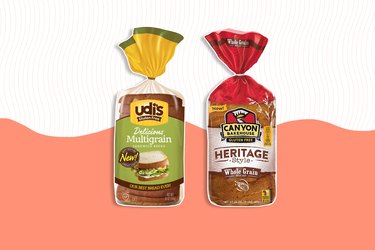
If you need a GF alternative to whole-wheat bread, seek out options made with whole-grain GF flours instead of ones containing mostly refined flours and starches (like white rice flour or potato starch). "Look for breads made with egg whites, too, since these typically result in rich, fluffy loaves," Norton says.
Brands we love: Canyon Bakehouse Heritage Style Whole Grain Gluten-Free Bread and Udi's Gluten Free Delicious Multigrain Sandwich Bread
2. Gluten-Free Crackers
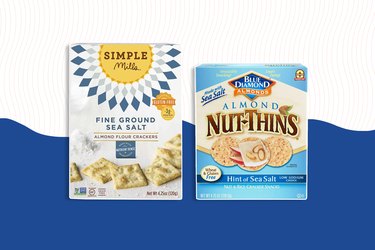
Lots of GF crackers are made mostly of low-nutrition ingredients like cornstarch, dextrose and palm oil. Norton prefers options whose main ingredient is almond flour. They're high in protein and heart-healthy fats, plus, they have a rich flavor and texture, she says.
Brands we love: Simple Mills Almond Flour Crackers and Blue Diamond Almond Nut Thins
3. Gluten-Free Wraps
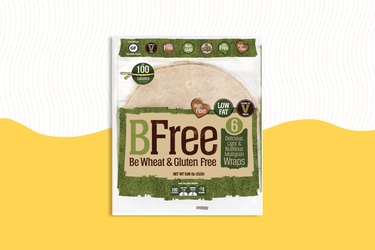
Options with brown rice flour as the main ingredient are winners in the flavor, texture and fiber departments, Norton says. Again, steer clear of wraps made mostly of low-nutrition ingredients like starches or palm oil.
A brand we love: BFree Gluten-Free Multigrain Wraps
4. Gluten-Free Pasta
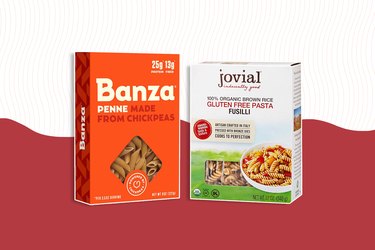
The rules for healthy gluten-free pasta are basically the same as for wheat: "Go for products with whole-grain flour as the main ingredient," Norton says. You'll get more fiber, protein and vitamins and minerals per forkful compared to pastas made from refined flours or starches. Noodle options made from bean flours are also a good choice.
Brands we love: Jovial Foods 100% Organic Gluten-Free Brown Rice Pasta and Banza Chickpea Pasta
Read more: 9 Foods You Didn't Know Contain Gluten
5. Gluten-Free Breadcrumbs
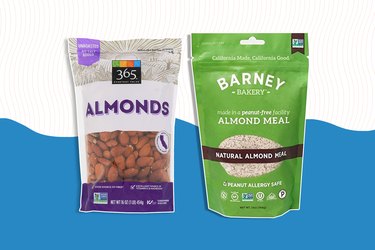
You'll get a more robust flavor — and nutritional bang for your buck — by using toasted, finely ground nuts in place of the usual white bread crumbs. "Finely ground almonds lend a crunchy texture and delicious flavor to fried meals and casseroles," Norton says.
Here's another idea: Simply toast up some leftover whole-grain gluten-free sandwich bread and blend it in the food processor.
A brand we love: 365 Everyday Value Raw Unsalted Almonds and Barney Natural Almond Meal
6. Gluten-Free Couscous or Orzo
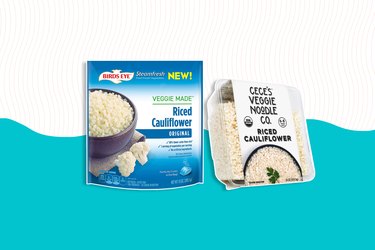
Finely ground cauliflower is a subtle-tasting, nutrient-packed substitute for tiny pasta shapes like orzo and couscous. "It's similar in texture and has a mild taste, and cooks quickly," Norton says. You can buy cauliflower already riced or blend fresh florets in the food processor.
Brands we love: Birds Eye Steamfresh Veggie Made Riced Cauliflower and CeCe's Veggie Co. Riced Organic Cauliflower
7. Gluten-Free Flours for Baking
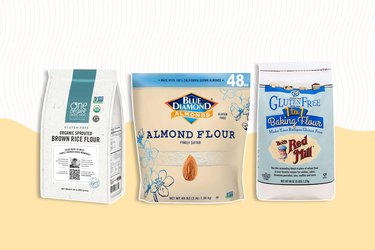
Whether you're looking to make muffins or quick breads, cakes, cookies or pizza dough, baking without wheat flour can sometimes be challenging. "Wheat flour contains gluten, which serves as the 'glue' to bind a recipe together. It also gives baked goods their stretchy texture," explains Jenny Finke, a certified integrative nutrition coach and founder of Good for You Gluten Free.
That's not to say it's impossible, of course. The key is understanding your gluten-free flour options and using them in a way to closely mimic the properties and texture of wheat. Here's a look at some of the best GF flour alternatives and why they're worth using.
Almond Flour
Almond flour is made from ground almonds, so it's packed with the same nutrition as whole almonds — like protein, vitamin E and calcium. It's also rich in healthy monounsaturated fats, which can give baked goods a moist, buttery texture, Finke says.
How to use it: Use one-third less almond flour than wheat flour for breads and one-fourth less for cookies, muffins or cakes, Finke recommends.
Brands we love: Blue Diamond Almond Flour and 365 Everyday Value Almond Flour
Cassava Flour
This grain-free flour is made from the dried, ground cassava root. The mild flavor and light texture make it a good sub for wheat flour — but with more good-for-you nutrients like fiber, vitamin C and potassium.
How to use it: You can swap cassava flour in a one-to-one ratio for wheat flour by weight (but not by volume). "A cup of wheat flour is about 130 grams. That means you can swap 130 grams of cassava flour and get a similar result," Finke says.
Brands we love: Otto's Naturals Cassava Flour and Terrasoul Superfoods Organic Cassava Flour
Chickpea Flour
Chickpea flour (sometimes called chana besan) is just made of dried, ground chickpeas, so it's a grain-free option that's packed with protein, fiber plus minerals like iron and magnesium. And it's got a sweet, almost creamy flavor and texture — so it won't make your baked goods taste beany.
How to use it: It's an awesome option for fluffy, high-protein pancakes. "It can work in a one-to-one ratio for wheat flour if you use a leavening agent like baking powder," says vegan chef and dietitian Gena Hamshaw, RD.
A brand we love: Bob's Red Mill Stone-Ground Garbanzo Bean Flour
Brown Rice Flour
Since it's made from the whole grain, brown rice flour serves up all the same nutrients as brown rice itself — including fiber, magnesium, vitamin B6 and iron. Plus, the mild, nutty flavor works well for both sweet and savory baking, Hamshaw says. For the best results, opt for superfine brown rice flour — it's smoother and less gritty.
*How to use it: *Blend it with another GF flour plus a starch for the fluffiest results. "I'd suggest one part brown rice flour, one part sorghum or millet flour and one part potato or tapioca starch," Hamshaw recommends.
Brands we love: One Degree Organic Gluten-Free Sprouted Brown Rice Flour and Anthony's Fine Brown Rice Flour
Corn Flour
Like cornmeal, corn flour made from whole pulverized corn — which is a whole grain, FYI! The difference? It's ground much finer, giving it a more delicate texture. "It can be appropriate for more tender baked goods than cornmeal," Hamshaw says.
How to use it: Take advantage of corn flour's naturally sweet, nutty flavor by using it in quick breads, muffins or cornbread. For the best texture and flavor, Hamshaw recommends blending one part corn flour with one part brown rice flour and one part potato or tapioca starch.
Brands we love: One Degree Organic Gluten-Free Sprouted Corn Flour and Bob's Red Mill Gluten-Free Corn Flour
Coconut Flour
Coconut flour is made from dried coconut meat, so it's a good option if you're looking for a grain-free or keto-friendly flour. Coconut flour is packed with fiber and iron, too.
How to use it: "Coconut flour is very thirsty, which means it can result in dry batters and baked goods," Hamshaw says. A good place to start is by using a fourth less coconut flour than wheat flour, but you may need to experiment with adding in some extra liquid.
Brands we love: Milliard Organic Coconut Flour and Anthony's Organic Coconut Flour
Oat Flour
Like whole oats, oat flour is rich in soluble fiber, which may be helpful for maintaining digestive regularity, says Hamshaw. "I find it offers a smooth, silky texture in baked good and a very mild taste," Finke says.
How to use it: Oat flour works best when combined with other GF flours, say Hamshaw and Finke, so try experimenting to see what works for your favorite recipes. If you're using it in a one-to-one ratio for wheat flour, try adding a quarter teaspoon of xanthan gum to help thicken and emulsify your batter.
Oat flour is easy to make at home by simply grinding rolled oats in the food processor until powdery. (Just make sure the oats are labeled as gluten-free, otherwise, they could potentially contain trace amounts of gluten.)
A brand we love: GF Harvest Gluten Free Certified Organic Rolled Oats
Sorghum Flour
Made from ground sorghum grain, sorghum flour has a sweet, mild flavor and gives baked goods a light texture. And since it's a whole-grain flour, it's a solid source of fiber.
How to use it: Sorghum works best in combination with other GF flours like oat flour, plus some potato or tapioca starch for thickening. "It might take some trial and error to find a formula that works!" Hamshaw says.
A brand we love: Big Green Organic Food Organic Sorghum Flour
Gluten-Free Flour Blends
These premixed blends contain a mix of GF flours, starches and thickeners and are designed to be directly substituted for wheat flour. "They've been tested for consistent results, so they're a good option when you want good texture in baked goods without a lot of experimentation," Hamshaw says.
How to use them: Just follow the directions on the package. Most GF mixes can be swapped in a one-to-one ratio for wheat flour.
Brands we love: Bob's Red Mill Gluten Free 1-to-1 Baking Flour and Cup4Cup Gluten Free Flour
Tip
While some gluten-free ingredients also happen to be low-carb, that’s not always the case. Plenty of gluten-free alternatives are made from high-carb ingredients like rice flour, cornstarch, potato starch, legumes, fruit and even sugar, Norton says. So if you’re looking to eat GF and low-carb, make sure to read package labels closely.